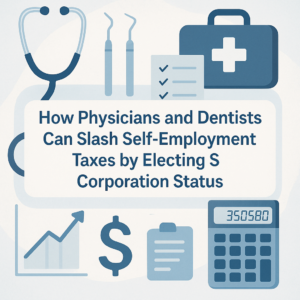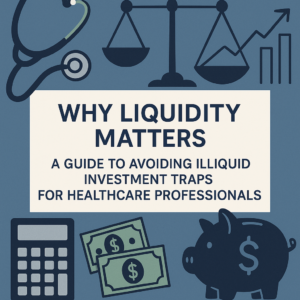Taxes are a significant part of our lives, influencing the financial planning of both individuals and businesses. State income taxes vary widely across the United States, and high-income earners often seek ways to legally minimize their tax burden. For young healthcare workers, including physicians, doctors, dentists, pharmacists, physical therapists, and psychologists, understanding these strategies is crucial for effective financial planning. This blog post explores how high-income individuals minimize their tax liabilities by avoiding paying state income taxes in high-tax states like New York.
Understanding Tax Residency
Each state has its own rules and criteria to determine if an individual is considered a resident for tax purposes. These rules are crucial as they dictate where and how much an individual pays in state taxes. In high-tax states like New York, understanding these rules can lead to significant financial savings.
In general, tax residency is dictated by a combination of physical presence in the state and the intent to make that state one’s domicile. A domicile is the place where an individual has their permanent home and where they intend to return whenever they are away. States like New York have a specific threshold, known as the 184-day rule, which stipulates that if an individual spends 184 days or more in the state in a given year, they are considered a resident for tax purposes.
Criteria for Tax Residency in High-Tax States
States such as New York use several criteria to determine tax residency, including:
- Physical Presence: Spending over 183 days in New York can classify you as a resident, subjecting you to state income taxes on your worldwide income.
- Permanent Place of Abode: Owning or maintaining a home in the state indicates an intent to stay, often resulting in tax residency.
- Business Connections: Income derived from business activities within the state can influence tax residency status.
- Family Location: The state where an individual’s family lives can play a role in determining residency.
- Social and Community Ties: Participation in community activities, such as clubs or religious institutions, may signal an intent to remain in the state.
- Voter Registration: Registering to vote in a state can indicate residency intent.
- Driver’s License: Holding a driver’s license from the tax-friendly state reinforces one’s intent to be a resident there.
- Financial Accounts and Professional Licenses: The location of banks, brokerage accounts, and even professional licenses can affect residency determinations.
Understanding these factors helps in strategic planning to avoid unintended tax residency.
Strategic Planning for Healthcare Professionals
Healthcare professionals often move between states for residencies, fellowships, and job opportunities. Strategic tax residency planning involves:
- Evaluating job offers not just by salary but by the potential state tax liabilities.
- Planning relocations to states with no or lower income taxes when possible.
- Keeping records of time spent in each state to avoid unintended tax residency.
Creative Tactics
High-income individuals employ several sophisticated strategies to avoid exceeding the 184-day threshold, thereby minimizing their state tax liabilities legally. Here are some of the most common methods:
Strategic Travel Planning:
- Wealthy individuals often plan their travel meticulously to avoid spending too much time in high-tax states. For example, planning flights to land just after midnight can prevent the day from being counted as a full day in the state.
- Similarly, individuals might sit in cars at the border of high-tax states until the clock strikes midnight before entering, ensuring they do not trigger the 184-day rule.
Dual Residencies:
- Maintaining residences in both high-tax and no-tax states allows individuals to split their time effectively, ensuring they spend fewer than 183 days in the high-tax state.
- States like Florida offer no state income tax, making it a popular domicile for individuals looking to minimize tax liabilities.
Careful Tracking and Documentation:
- Wealthy individuals often keep detailed records of their travels, including flight itineraries, hotel receipts, and other documentation, to prove their physical presence (or absence) from the high-tax state.
- Technology aids in this process with apps specifically designed to track days spent in different states. Apps like TaxBird and Monaeo help wealthy individuals track their location automatically, providing a seamless way to ensure compliance with the 184-day rule. These tools are especially useful for healthcare professionals with hectic schedules and frequent travel.
Case Examples of Creative Strategies
For a more vivid understanding, consider the following hypothetical examples:
1. The Midnight Flyer:
Dr. Smith, a high-income surgeon, lives in New York but owns a home in Florida. He ensures that all flights to New York land after midnight and that return flights are scheduled before midnight, reducing the countable days in New York.
2. The Border Timer:
Jane, a wealthy pharmacist, practices in New York but resides in New Jersey just across the state border. She spends her evenings in New Jersey and meticulously plans her entry into New York to start after midnight, ensuring her presence in New York remains under 183 days.
These strategies, while creative, must always stay within legal bounds to avoid repercussions from tax authorities.
Financial Impact Analysis
Relocating or managing residency status can lead to substantial tax savings, especially for high-income healthcare professionals like doctors, dentists, and pharmacists. Let’s examine the financial impact in detail:
1. State Income Tax Rates:
- New York has one of the highest state income tax rates, reaching up to 9.65% for incomes exceeding $1.07 million for a single filer. Additionally, New York City adds a local income tax of up to 3.876%, totaling over 13% combined.
- Comparatively, states like Florida, Texas, and Nevada have no state income tax, leading to zero percent on the same income.
2. Annual Tax Savings:
- A healthcare professional earning $1 million annually could save over $100,000 in state and local taxes by relocating from New York to a no-tax state like Florida.
- Adjusted for other high-income brackets, even those earning between $500,000 and $1 million could save tens of thousands of dollars annually by leveraging tax residency strategies.
Long-Term Impact on Wealth Accumulation
Consistently applying these strategies over several years can significantly boost long-term wealth accumulation. Compound savings on state taxes can be invested further, potentially yielding high returns. Consider this scenario for high-income healthcare professionals:
1. Five-Year Savings Plan:
- Dr. Johnson, an orthodontist earning $1.2 million annually, relocates to Florida, saving approximately $120,000 in taxes annually.
- Over five years, this amounts to $600,000 in savings. If invested with a modest annual return of 5%, these savings could grow to around $696,000.
2. Investment Growth:
- Higher state tax savings can be allocated toward various investment vehicles, including retirement accounts, stock portfolios, or real estate, optimizing long-term financial growth.
- For a younger healthcare professional, starting this strategy early could lead to millions in additional wealth by retirement age.
Moral and Ethical Considerations
The topic of tax avoidance inevitably brings up ethical considerations. It’s crucial to address whether minimizing tax obligations equates to shirking social responsibilities. High-tax states often justify their tax rates by pointing to the public services they provide, from education and healthcare to infrastructure and social security nets.
1. Ethical Debate:
- Some argue that high-income earners, who benefit greatly from a state’s services and infrastructure, should pay their “fair share” in taxes to support these services.
- Others contend that individuals have the right to be taxed fairly and can use legal means to protect their income. High taxes can be seen as a penalty for success, prompting individuals to seek lawful ways to reduce their tax burden.
2. Contribution to State Revenue
High-income individuals often contribute a significant portion of state tax revenues. In states like New York, the top 1% of earners pay a substantial share of the total income tax collected.
3. Redistribution Concerns:
- With large-scale tax avoidance, states may face revenue shortages, affecting their ability to fund essential services. This shift could lead to higher taxes or reduced services for middle and lower-income residents.
- States may react by tightening tax residency rules, increasing audits, and implementing stricter regulations.
Balancing Ethical and Legal Tax Planning
Effective tax planning requires a balance between legally minimizing tax liabilities and fulfilling societal obligations. Here are some ways to approach this:
1. Transparent Planning:
Communicate openly with tax advisors about the ethical considerations and ensure that all tax strategies employed are strictly within legal boundaries.
2. Philanthropy:
High-income earners can balance tax savings with charitable contributions, supporting causes they care about while benefiting from tax deductions.
3. Community Engagement:
Actively participating in and contributing to community initiatives can help high-income earners give back to society, offsetting some of the moral concerns associated with tax avoidance.
Conclusion
Effective tax planning is a critical aspect of financial management for high-income individuals, including young healthcare workers. Legal strategies to minimize state income taxes can provide significant financial benefits, but it’s essential to balance these strategies within ethical and legal boundaries. Understanding tax residency rules, employing creative yet lawful avoidance tactics, and considering the long-term financial impacts are all part of a comprehensive approach.
At the same time, it’s crucial to engage in discussions about the moral obligations of high-income earners and the potential policy reforms that can create a more equitable tax system. By staying informed, consulting with qualified professionals, and participating in community and philanthropic initiatives, healthcare professionals can navigate the complex landscape of tax planning responsibly and effectively.
Disclaimer: The information provided in this blog post is for educational purposes only and does not constitute legal, financial, or tax advice. Readers are encouraged to consult with a qualified tax professional or financial advisor before making any decisions regarding tax planning strategies. The viewpoints expressed in this article are intended to provide a balanced discussion and should not be interpreted as an endorsement of any particular tax avoidance tactic.






